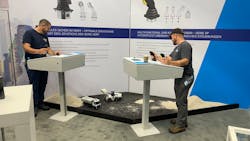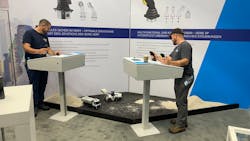Joysticks and electronic integration can help operators work closely with equipment at hand
Antonin Deschamps is the global product manager at APEM. He ensures the product roadmap meets market trends and customer needs, and he supports custom product inquiries. Deschamps holds a master’s degree in embedded electronics from CESI school of engineering in France.
Tell us about your company’s state-of-the-art operator-interface technology for manufacturing.
What have been the biggest improvements to operator-interface technology in the past five years?
Antonin Deschamps, global product manager, APEM: In terms of industrial interfaces like joysticks designed for heavy-duty usage, there are several technology developments that improve the operator experience. Contactless operator presence detection enhances safety. Careful ergonomic design is easier on the operators. More functionality integrated onboard the joystick, especially with haptic feedback and visual feedback, improves joystick usability. Combined, these technologies support the digital transformation of industrial equipment from hydraulics to purely electronic joystick controls, while retaining similar actuation feeling.
What’s the most innovative or efficient operator-interface technology application you’ve ever seen or been involved with?
Antonin Deschamps, global product manager, APEM: We have been partnering with a research lab in Europe to integrate new technology into joysticks, providing intuitive haptic feedback combined with the capability of dynamically reprogramming the joystick with various profiles. For advanced applications, this enables a joystick to adapt on the fly to changing user needs while in operation, such as shifting the functionality among modes like single- or dual-axis, friction hold and much more, depending on the application need.
Antonin Deschamps, global product manager, APEM: Joysticks and electronic integration are a way of helping operators to work close enough to the equipment at hand, while remaining distant enough for safety. Control cabins and control rooms can be far removed from an actual target. For the most precise control and best efficiency, it is often necessary for operators to use joysticks and associated controls near the target equipment but at a safe working distance.
Can you explain how software development has changed operator interfaces in manufacturing?
Antonin Deschamps, global product manager, APEM: Software development has drastically improved operator safety by integrating more algorithms for enhanced diagnosis. For example, instead of simply acting as a basic input device, a modern joystick can include integrated intelligence to monitor abnormal voltages and temperatures, external electromagnetic noise, discrepancies between redundant sensors and more in support of fail-safe operation.
Software can also drive more sophisticated feedback, such as backlighting, vibration and audible signals. Also, by modifying the output profile and linearity, it is possible through software to improve the smoothness and stability of the resulting machine motion. These advanced capabilities are enabled in part by joysticks compatible with modern industrial communication protocols such as controller area network flexible data-rate (CAN FD) and EtherCAT.
What future innovations will impact the use of operator-interface technology in manufacturing operations?
Antonin Deschamps, global product manager, APEM: Many industries are moving to touchscreen operator-interface panels, and some are experimenting with 3D-gesture technologies. These will continue to improve and find many applications. However, there are also plenty of cases where more physical and tactile feedback—like that offered with joysticks, thumbsticks and associated devices—will continue to provide the optimal user interface.
About the Author
Mike Bacidore
Editor in Chief
Mike Bacidore is chief editor of Control Design and has been an integral part of the Endeavor Business Media editorial team since 2007. Previously, he was editorial director at Hughes Communications and a portfolio manager of the human resources and labor law areas at Wolters Kluwer. Bacidore holds a BA from the University of Illinois and an MBA from Lake Forest Graduate School of Management. He is an award-winning columnist, earning multiple regional and national awards from the American Society of Business Publication Editors. He may be reached at [email protected]

Leaders relevant to this article:



